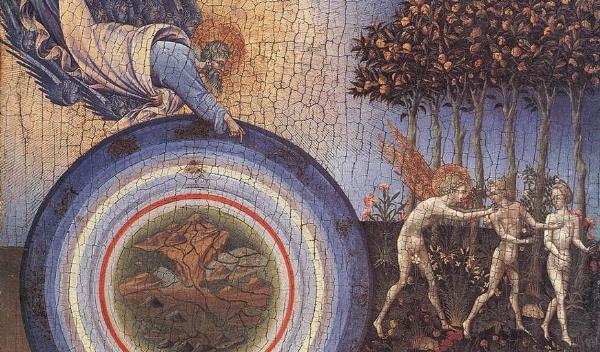If the Christian faith is a ‘religion of the book’, a tradition handed down through the centuries, how are we to make sense of that book and that tradition when we speak today in a very different language? John Moffatt SJ explores the place of reason and reasonableness in interpreting, understanding and deepening our faith.
“If the Bible says God created the world in six days, with the creatures in all their kinds, and if the Bible is the word of God and if God always tells the truth, then the world was created in six days, with all the creatures in their kinds.”
It can be reasonably easy to identify and take issue with the cruder fundamentalist approaches to Biblical text, especially if one is Catholic and less reliant on “the whole text, and nothing but the text”, for answers to life’s questions. It is clear that at least some texts need interpretation if we are to make sense of them for us. It is equally clear that only some form of interpretation can help us communicate that word to our contemporaries who are looking for reasonable answers to the problems of life. In other areas of biblical text, though, it is less clear what needs reasonable interpretation (isn’t it reasonable enough already?) – and when it comes to text which is very close to the foundations of our personal faith, any hint of interpretation at all can seem quite threatening.
That word ‘reasonable’ is vague at the moment. But here are some of the things it might mean: ‘making sense (to us), fitting in with our trusted ways of understanding the world, logical, evidence-based, congruent with the science that works, demonstrable, persuasive, probable’. This leaves ‘reasonable’ still surprisingly vague. Unfortunately, one of the things that we are going to have to cope with is that ‘reason’ is not as precise a concept as we would all like it to be. This will affect where we draw the line in ‘reasonable’ interpretation. For instance, if we believe that there is an all-powerful God, then there is nothing illogical in the concept of such a being causing extraordinary events, and reports of witnesses to divinely-caused extraordinary events will count as persuasive. If, however, we do not have that belief, then reports of witnesses to divinely-caused extraordinary events will be much less persuasive, since that kind of thing is (in our reasoning) intrinsically improbable.
When we read statements like the one in italics above, many of us are inclined to be a little smug – how could we be so simple-minded as to think that truth meant something so literal as that fragment of argument implies? We can happily believe in a 15 billion year old universe and the theory of evolution, side by side with a sophisticated understanding of the Biblical legends of creation and the fall. We don’t need to be literal: metaphors and myths can still state important truths about the world as it is. But it is perhaps useful to remind ourselves that it is only in the last sixty years that Catholics have been officially allowed to read the first three chapters of Genesis as non-historical texts written by someone other than Moses. It was only under John Paul II that Darwin’s theory of evolution received a green (rather than amber) light from a Pope.
Nevertheless, here at the beginning of the twenty-first century, we are allowed to see these sacred texts in a different way. We can recognise different genres: legend (Exodus), history (Ezra, Maccabees), pious fable (Tobit, Jonah), poetry, prophecy, foundation-myth, cult law, social law and so on and on. We can recognise big narrative themes: creation, rescue, covenant, Messiah, chosen people, sin and forgiveness. We begin to recognise how ancient texts can speak to us about our present condition. It does not disturb us that some texts evolve, the work of many hands, with corrections, adaptations and alternative versions of events and speeches side by side. We see prophetic texts being produced in particular periods of history, interpreting events, many of which have echoes in the archaeological record, or in the histories of other cultures. We become aware of external cultural influences on the language, imagery and thought of a particular people over time. This is enriching, and allows us to read the presence and the word of God in one people’s history in a way that touches our own personal history. The word of God becomes a metaphorical narrative that transforms our self-understanding.
As long as we remain in the Old Testament – always filtered and interpreted in our tradition – perhaps we do not mind so much. We worry less about the historical detail, what really happened. However the moment we step into the New Testament, the difference between myth and history becomes hugely important to Christians. How far are the authors telling a story their way and how far are they being ‘true to the facts’? We are put on the spot. If we are less concerned about the miracles wrought by the Lord to rescue his people from Egypt, why should we be any more concerned about the miracles attributed to Jesus of Nazareth? We notice that in the New Testament’s interpretation of the Old, it is assumed that the Lord did indeed do these things for his people throughout the ages. And there is a logical point here: if miracles make us uncomfortable and we do not believe that he really raised up a Messiah and rescued his people, then why should we believe that he has done so now? We are expected to recognise something like a rule of induction over time: this, again and again, is how the Lord is, who rescues his people with a mighty hand and outstretched arm. Suddenly, perhaps it does seem to matter what happened at the Red Sea. Our God is revealed in events.
But then, being reasonable becomes much more difficult. Our faith tradition has its own logic of ‘typological’ reading, the history of Israel, the Law and the Prophets prefigure or point to Jesus Christ, his life, death and resurrection. Put the other way round, the life, death and resurrection of Jesus Christ give a new way of reading the History of Israel, the Law and the Prophets. Stories of significant and extraordinary events become a part of the evidence that this grand narrative of salvation is real, and invite us to hope that the significant and extraordinary in some way belong in our lives as well. If Jesus did not rise from the dead, then our faith is in vain. But how easy is it now, in our current culture, to continue to be faithful and reasonable? Our culture tends to shun the miraculous and look for natural explanation, whether by diminishing the status of the written evidence (“ignorant and credulous people in far off places, distant in time”) or by giving natural accounts of events previously regarded as impossible (“it was only a sudden storm, a chaos event”) – or by emptying any historicity into the author’s deeper message (“it is a metaphor for healing spiritual blindness”).
There are other ways in which the process of reasonable interpretation and the difference between an ideal account of bare facts and a multi-faceted narrative challenge us at deep levels. If we pray the scene of Mary and the angel Gabriel, surely our prayer is undermined if we think of them as characters in a play, rather than persons in history? Yet surprisingly even here we can begin to see a way forward. A narrative does reveal meaning, as well as concealing historical reality. Bare events are often too ambiguous or too insignificant as they appear in history, and yet do indeed have a deep reality in a process that only a narrative can reveal. On the first Good Friday three more insignificant, failed revolutionaries died at the hands of Roman justice. Only a passion narrative, woven out of fragments of memory and re-interpreted texts from the Psalms and the Prophets can help us see the universal meaning of one of those deaths. The characters in the play can tell us truths we would not otherwise see about the people they represent.
Yet we still need the bare events that underpin this narrative, though how many and of what kind will vary according to the boundaries of our reasonableness. We will always have a problem with one version of the miraculous: a violation of the laws of nature. We know too much about how the world ought to work and our ordinary lives are too ordinary. We may have less of a problem with signs, though. We are certainly aware (whether we believe in God or not) that the natural world is stranger than our everyday sense of what is usual, normal and probable. If we are honest, there will always be a space for the surprising. What we find in the narratives of New and Old Testament are surprises that have meaning for those who witness them. Some of the surprises are almost trivial: a catch of fish after a long and fruitless trawl through the night. Some are immensely significant but hardly miraculous: the new emperor Cyrus decrees that the Jews may return to rebuild their temple in Jerusalem. Some are inexplicable as far as we know the world: the healing of a blind man. But all of them – in the moment, in the context, in a relationship – are moments in which the power and love of God is communicated as a reality, in a personal here and now. We learn to read such signs in our experience. In that way, salvation history goes on.
So we can look on the scriptural texts, all of them, as partial narratives helping the reader recognise the signs of an enduring and dynamic relationship between God and our world. Sometimes the narratives are closer, sometimes further away from what we might easily accept as bare events. The penalty for sophisticated reading of text is to have to trust that there are enough real events to guarantee the truth of the grand narrative, while being uncertain what they actually may have been. But it is only on this condition that we enter the dialogue of reasons.
And it cannot stop at the Bible. Salvation history has continued. Once we have made these steps with scripture, we then recognise there is another body of text to work with, the Christian tradition itself. What tools do we have for reading and making sense of the vast and complex set of material preserved in writing, in ritual action, in prayer, in social action throughout twenty centuries? How do we search for deep significance in events, in doctrines, in injunctions? As with biblical text, here too we need to break free from flat or literal reading. We need again to know genre, context, histories and politics. And as with biblical text this can very quickly become very unnerving.
Perhaps more than in the biblical text, the Christian Church has highlighted not narratives, but definitions, not personal stories, but universal ordinances. Yet what happens when definitions, on closer inspection, seem to break down because they are in a language we no longer use (“consubstantial”, “hypostasis”)? Some areas of the language for talking about God – at one time fully harmonised with the best of human reason – seem now to be alien to the language of reason familiar to us, a mechanism whose parts work but do not engage with the rest of the machine. What goes for definitions can go too for ordinances. They also can seem alien to our current reasonable understanding of the human condition. The vast edifice of teaching that articulates the ambiguous narratives of scripture into a coherent whole itself needs interpretation in the light of new reason and reasoning. It is essentially incomplete.
If Adam and Eve are a myth, then what exactly is original sin? If original sin is a questionable concept, then what does it mean to say, as we often do, “Jesus died to rescue us from the punishment due for original sin”? We can explore Augustine and his use of Paul, the historical arguments he engaged in, which scriptural texts he took as his logical base and which philosophical axioms guided his thinking. Was there a deep message here that can justifiably be otherwise articulated by those who do not accept his use of scripture? We look at the tradition and find before and after Augustine people who have taken Christian thought and texts in different directions.
When we read ethical injunctions proclaimed by Church authorities (of any denomination), we accept them as authoritative because they are issued by the competent authority and we are bound to obey that authority – whatever it says – just as we are bound to obey all the commandments of the Old and New Testaments. But when the commandments we accept are challenged by an alien culture, how can we begin to justify them unless they can be shown to be at the same time reasonable? Suddenly we are aware that we do not in fact obey all the commandments of the Old Testament (or the New), because we have interpreted them (for good or ill) in the light of the reasonable understandings of different cultures. But then are not all commandments within the tradition, even those most fiercely proclaimed, subject ultimately to the test of reason? Or, more disturbingly, are they not subject to the test of reasonings (plural) that may differ substantially from that reasoning in which they once were grounded? Things that seemed sacred and secure, a clear pathway to God, are called into question by those who have a different account of human flourishing. Entering into the dialogue of reason, once again, has a cost.
So if we are to be reasonable, we must live with a great deal of trust and a great deal of uncertainty. We can be comforted, though, and find our trust in the tradition in the widest sense – not just the articulated dogma that wins in the narrative of heresy defeated, but a diversity of interpretations and understandings of the meaning of the faith in every age, analogous to the diversity present throughout scripture. When we reach back beyond Augustine we can be comforted that progress in understanding does not move in smooth lines – often a sudden return to an earlier articulation can be helpful and enlightening. The ressourcement of Vatican II reveals how enriching a return to the roots can be, to a time of unresolved possibilities. We will find new ways of resolving those possibilities that take us in different directions. We must trust that sufficient of this tradition points towards a life-giving truth, even as we are unsure which parts of the tradition come closest to articulating that truth.
Throughout the Christian era and before it there has always been more than one way of being reasonable. That diversity is reflected in the texts, whether scriptural or dogmatic which attempt to articulate a narrative or a teaching, and point us towards the dynamic reality of our relationship with God. It is the challenging, but liberating work of Christian reasoning in every age to interpret the whole text so that its deep truth may be recognised and so can set us free.
John Moffatt SJ is Catholic Chaplain to the University of Oxford. He is the author of Beyond the Catechism: Intellectual Exercises for Questioning Catholics (Lulu, 2006)
![]() Oxford University Catholic Chaplaincy
Oxford University Catholic Chaplaincy
![]() Beyond the Catechism: Intellectual Exercises for Questioning Catholics
Beyond the Catechism: Intellectual Exercises for Questioning Catholics






